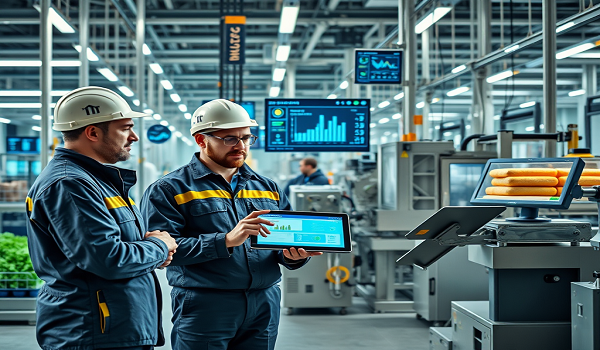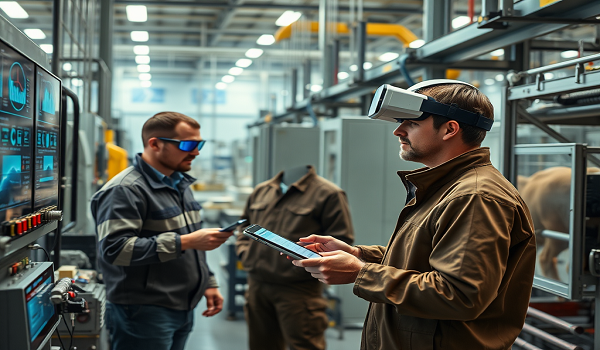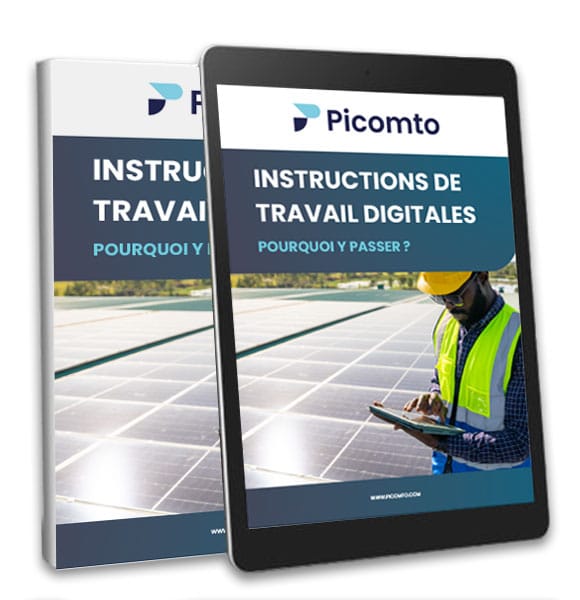Are you managing an agri-food company and wondering how to remain competitive in the face of current challenges? Digitalization in the agri-food industry appears as the unavoidable solution. But how can you concretely transform your plant? Where should you start? What results can you expect? Indeed, the agri-food industry faces major challenges:
- Increasingly strict quality standards
- Constant pressure on costs
- Growing shortage of skilled workforce
- Consumers demanding greater transparency

Key takeaways regarding digitalization in the agri-food industry:
- Digital transformation: Digitalization in the agri-food industry revolutionizes all production processes
- Concrete ROI: Reduction of downtime by 15-30% and productivity improvement of 10-25%
- Optimal traceability: Real-time monitoring of the production chain through IoT and blockchain
- Human capital: Accelerated training and preservation of know-how through digital tools
- Continuous innovation: Artificial intelligence and Big Data for process optimization
1. Concrete Benefits of Agri-Food Digitalization
Digital transformation is not limited to simple modernization. It generates measurable gains at all levels of the company. Let’s explore together the concrete benefits that digital brings to the agri-food sector.
1.1. Enhanced Traceability for Greater Safety
In a sector where food safety is crucial, traceability becomes a strategic lever. Thanks to digitalization, it gains in reliability, precision, and responsiveness.
The main advantages observed:
- Real-time tracking of each batch, from raw materials to finished products
- Simplified compliance with HACCP, ISO 22000, and BRC standards
- Instant reaction in case of non-compliance or health alerts
A figure to remember: 76% of consumers believe that traceability directly influences their purchasing decision. (Source: Food Marketing Institute).
Real case: The Agromousquetaires group strengthened its traceability with Picomto, by connecting its quality procedures to field data. Result: better transparency and a significant reduction in data entry errors.
1.2. Optimized Production to Reduce Costs
Digitalization offers powerful levers to optimize industrial performance. It directly impacts productivity, costs, and sustainability.
What digital optimization enables:
- +15 to +30% efficiency on production lines
- -10 to -20% food waste, thanks to better process control
- Automation of time-consuming tasks: paper entries, manual controls, printing
Concrete example: a French dairy integrated Picomto into its maintenance and cleaning procedures. In just six months, it reduced its line stoppages by 23%, while improving the reliability of its interventions.
2. Key Technologies of Digital Transformation
The digitalization of the agri-food industry relies on advanced technologies. Among the most impactful: the Internet of Things (IoT) and Artificial Intelligence (AI). These tools enable better production management and quality improvement, while reducing costs.
2.1. IoT in Service of Production
The Internet of Things changes how manufacturers monitor and manage their equipment. Through connected sensors, production data is continuously collected and analyzed. This opens the way to a new form of management.
The main contributions of IoT are as follows:
- Real-time monitoring of critical parameters such as temperature, humidity, or pressure
- Predictive maintenance that anticipates failures and reduces unexpected downtime
- Dynamic optimization of production conditions to gain performance
Many agri-food plants have already taken the leap, integrating IoT sensors into their production lines. This allows them to react quickly and make their processes more reliable.
2.2. Artificial Intelligence for Informed Decisions
AI constitutes a powerful lever for exploiting data at large scale. It transforms volumes of raw information into concrete recommendations. It helps decision-makers act faster and more accurately.
Its applications are multiple in the agri-food sector:
- Predictive analysis of demand to better anticipate volumes to produce
- Early detection of quality anomalies to avoid losses and product recalls
- Continuous optimization of recipes and processes according to field feedback and quality objectives
Thanks to AI, manufacturers can adjust their decisions in real-time, improve customer satisfaction, and strengthen their competitiveness.
3. Challenges and Solutions of Agri-Food Digitalization
While digitalization offers major opportunities, it also comes with several challenges. Understanding these issues allows for effective and sustainable responses.
3.1. Change Management: A Major Challenge
Digital transformation profoundly modifies work habits. This change can cause tensions, particularly within teams.
The main obstacles encountered are as follows:
- Natural resistance to new methods
- Growing need for digital skills
- Sometimes complex reorganization of internal processes
To succeed in this transition, adopt a progressive and structured approach. Here are some best practices:
- Start with a small-scale pilot project
- Identify driving collaborators to support change
- Value each step achieved to maintain momentum
Appropriate support promotes adherence and limits barriers to digital tool deployment.
3.2. Cybersecurity: An Absolute Priority
With digitalization, industrial data becomes strategic. Their protection is therefore essential to guarantee business continuity and preserve competitiveness.
The sensitive information to secure is numerous:
- Manufacturing recipes and processes
- Product traceability data
- Customer files and logistics information
Modern solutions, like Picomto, integrate advanced protection mechanisms:
- Secure encryption of exchanges and stored data
- Reinforced authentication system to limit unauthorized access
- Automatic backups to prevent any information loss
4. Impact on Agri-Food Professions
Digital transformation is not limited to tools. It redefines roles, missions, and skills within teams.
All professions are concerned, from field to management. Traditional jobs evolve to integrate new technologies. Profiles must adapt to more connected environments that are more demanding in terms of analysis and autonomy.
Here are some concrete examples:
- Operators become more versatile, capable of interacting with digital interfaces
- Managers pilot performance in real-time through digital dashboards
- Technicians use tools like augmented reality for maintenance or training
These evolutions require targeted support and progressive skill development.

5. Best Practices for Successful Digitalization
To succeed in your digital transformation in agri-food, a structured approach is essential. The objective: progress step by step, avoiding the most common pitfalls.
5.1. Key Project Steps
The success of a digital project relies on rigorous task planning. Each step counts to guarantee team adherence and tool performance.
Here are the main steps to follow:
- Conduct a digital maturity audit to assess the starting situation
- Define clear and priority objectives, aligned with the company’s strategy
- Select technologies adapted to real field needs
- Train teams to ensure coherent skill development
- Deploy solutions progressively, limiting operational disruptions
- Measure results regularly to adjust strategy if necessary
5.2. Pitfalls to Avoid
Certain errors can slow down or even compromise project success. It’s better to anticipate them from the start. The most frequent ones are as follows:
- Launching global digitalization without prioritizing
- Neglecting team training, a key factor for adoption
- Underestimating the importance of change management
- Choosing generic solutions that don’t meet the specific requirements of the agri-food sector
5.3. First Step: Digitalization of Work Instructions
A successful project often begins with simple but strategic actions. Digitalizing operational documentation is a first step with high impact.
The documents to prioritize are as follows:
- Quality control procedures
- Operating procedures and maintenance guides
- Training materials used in the field
This approach allows for structuring information, reducing errors, and standardizing practices.
5.4. Second Step: Team Involvement
Technology alone is not enough. Project success relies primarily on employee engagement. Here are the levers to activate to ensure good adoption:
- Train teams progressively, according to their real needs
- Identify internal relays to carry the project daily
- Value results obtained from the first steps to maintain motivation
Conclusion
Digitalization in the agri-food industry is no longer an option but a strategic necessity. Indeed, it allows you to:
- Strengthen your competitiveness
- Ensure the quality of your products
- Optimize your production costs
- Enhance your human capital
FAQ
Q: How does digitalization impact the food industry?
A: It optimizes production, strengthens traceability, and improves product quality.
Q: What is industry digitalization?
A: It’s the integration of digital technologies to automate and optimize all production processes.
Q: How to innovate in agri-food?
A: Adopt IoT technologies, AI, and blockchain to modernize your production processes.
Q: What technology is used in the food industry?
A: IoT, artificial intelligence, blockchain, and connected sensors transform food production.
Q: What is the main objective of digitalization?
A: Improve operational efficiency while guaranteeing optimal quality and traceability.
Q: What is the importance of food technology?
A: It guarantees food safety, product quality, and meets consumer requirements.






Leave A Comment